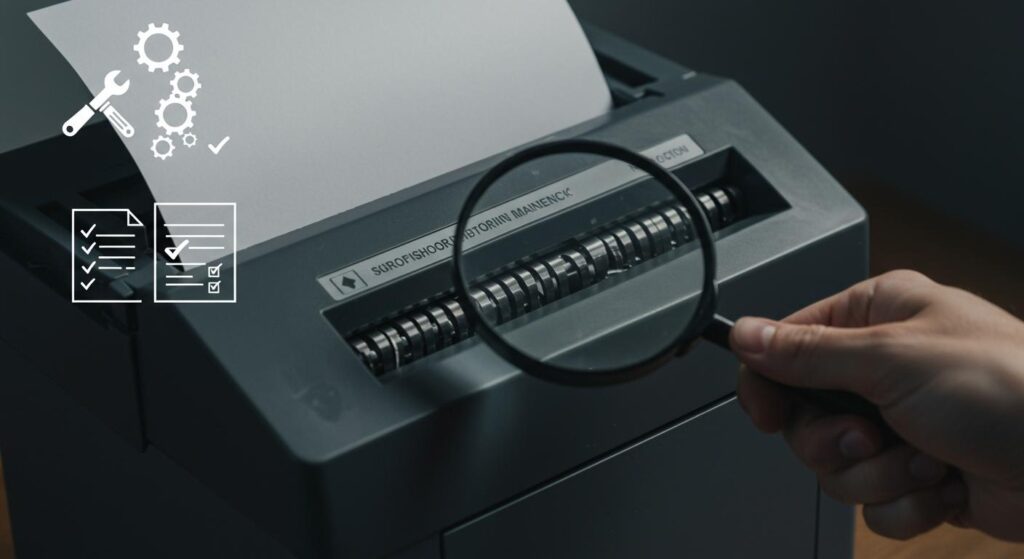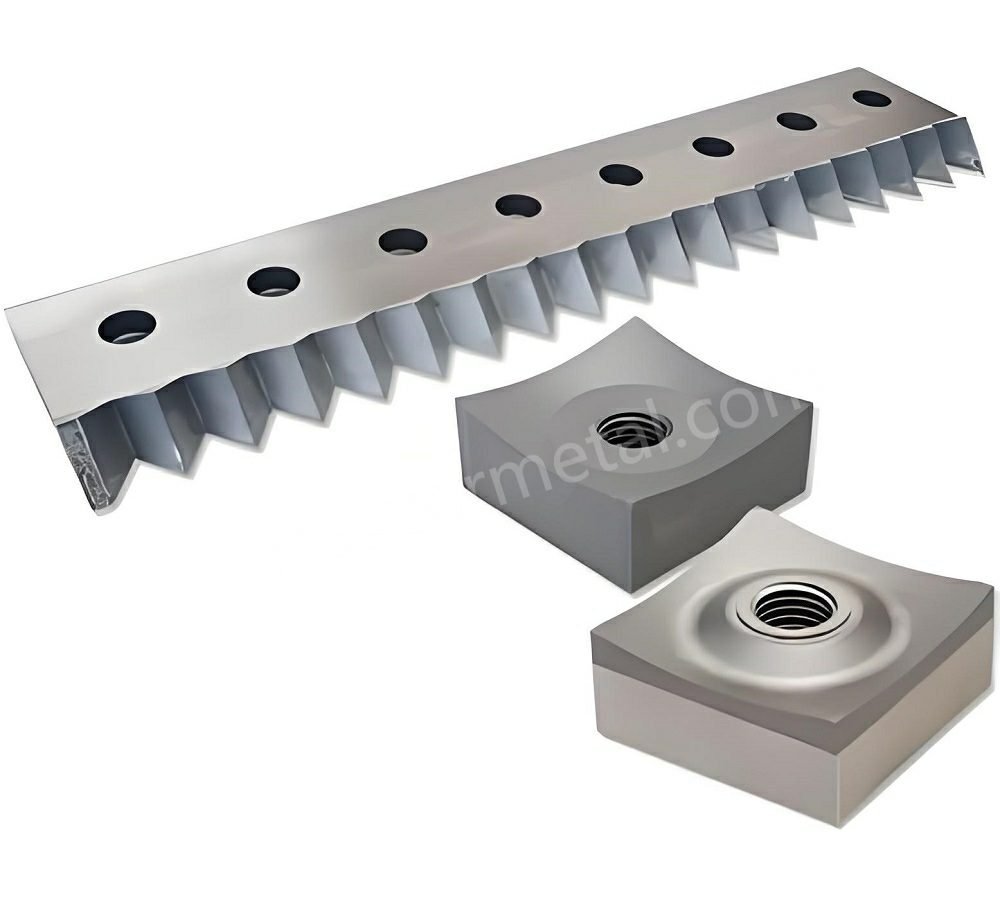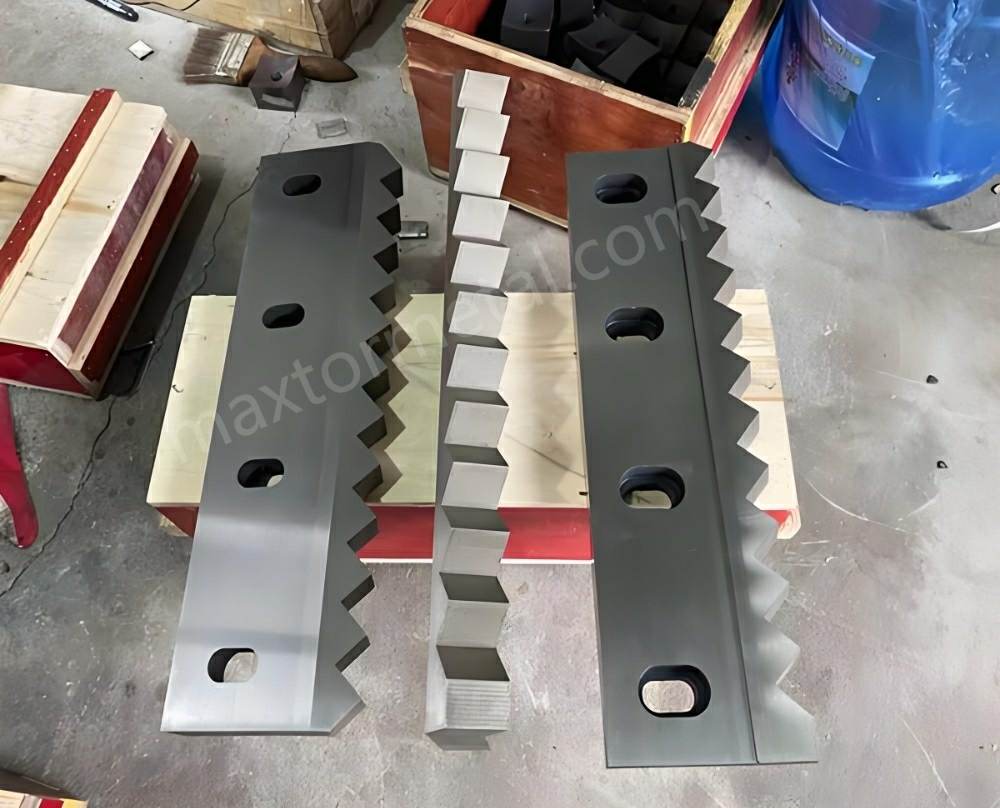
Anda ingin mesin penghancur kertas Anda berfungsi dengan baik. Anda juga ingin menghindari masalah yang mahal. Pemecahan masalah bilah shredder Membantu Anda menemukan masalah lebih awal. Hal ini memungkinkan Anda memperbaikinya dengan cepat. Pemeriksaan dan perawatan rutin membuat mesin penghancur kertas bekerja lebih baik. Hal ini juga membantu mesin penghancur kertas lebih awet.
| Aspek Utama | Dampak terhadap Umur dan Efisiensi Mesin Penghancur |
|---|---|
| Perawatan Reguler | Membuat mesin penghancur lebih awet dan menghentikan kerusakan. |
| Inspeksi Rutin | Menemukan masalah sebelum kegagalan besar terjadi. |
| Perawatan Pisau | Menjaga bilah tetap memotong dengan baik dan menurunkan tekanan motor. |
| Pelatihan Staf | Menghentikan kerusakan akibat kesalahan saat penggunaan. |
| Pengendalian Lingkungan | Mengurangi keausan akibat debu, kelembapan, dan perubahan suhu. |
Poin-poin Utama
- Merawat mesin penghancur kertas akan membantunya bertahan lebih lama dan mencegahnya rusak.
- Memeriksa mesin penghancur kertas Anda secara rutin membantu Anda menemukan masalah sejak dini. Ini menghemat waktu dan uang Anda.
- Pisau yang tumpul atau tua dapat memperlambat pekerjaan hingga 15-40%. Anda harus mengasah atau menggantinya bila perlu.
- Selalu cari bagian yang macet dan singkirkan bagian yang tidak perlu disobek. Ini membantu mencegah kerusakan.
- Jarak antar bilah harus pas untuk pemotongan yang baik. Sesuaikan dengan bahan yang akan Anda potong.
- Gunakan oli yang tepat untuk menjaga bilah tetap bersih dan berfungsi dengan baik.
- Ajari pekerja cara menggunakan mesin penghancur dengan benar. Ini membantu mencegah kesalahan yang dapat merusaknya.
- Lakukan rencana pemeliharaan rutin agar mesin penghancur kertas Anda bekerja dengan baik dan tidak rusak.
Mengenali 3 Tanda Utama Kerusakan Bilah Mesin Penghancur Industri

Bila Anda menggunakan mesin penghancur industri, Anda perlu menyadari masalahnya sejak dini. Pemecahan masalah bilah shredder Dimulai dengan mengetahui apa yang perlu diwaspadai. Berikut tiga tanda peringatan yang harus selalu Anda waspadai.
1. Penghentian Mesin Lengkap dan Pengacauan Material
Terkadang mesin penghancur kertas Anda tiba-tiba berhenti bekerja. Motornya mungkin mengeluarkan suara keras atau mati. Material dapat menumpuk dan tidak bergerak sama sekali. Panel kontrol mungkin menampilkan lampu indikator kelebihan beban atau lampu merah darurat. Ini adalah masalah yang sangat umum pada mesin penghancur kertas.
Tip: Selalu perhatikan kertas yang tersangkut atau sampah plastik yang tersangkut di bilah pisau. Terlalu banyak materi sekaligus Dapat menyumbat bilah dan membuat motor menjadi panas. Menggunakan bahan yang salah, seperti kardus atau kertas tebal, dapat menyebabkan lebih banyak kemacetan.
Penyebab utama kemacetan meliputi:
- Menaruh terlalu banyak materi pada suatu waktu
- Tidak mengeluarkan staples atau klip kertas
- Menggunakan benda-benda yang tidak dapat ditangani oleh mesin penghancur
Jika Anda menggunakan mesin penghancur plastik, plastik keras dapat memenuhi hopper dan menghentikan rotor. Anda harus membersihkan kemacetan dan memeriksa pisau penghancur untuk kerusakan apa pun.
2. Kehilangan Hasil yang Signifikan atau Kualitas Penghancuran yang Tidak Merata
Anda mungkin melihat mesin penghancur kertas Anda bekerja lebih lambat dari sebelumnya. Potongan-potongan yang dirusaknya mungkin terlihat berbeda ukurannya. Anda mungkin perlu sering menghentikan mesin untuk memperbaiki kemacetan atau mengubah pengaturan.
- Pisau yang tumpul membuat mesin penghancur bekerja lebih keras.
- Produktivitas dapat turun sekitar 15% jika bilahnya tidak tajam.
- Output dapat turun hingga 15-40% jika bilahnya tumpul atau tidak sejajar.
Jika Anda melihat kertas atau plastik robek keluar dalam bentuk gumpalan atau potongan, pisau penghancur Mungkin butuh bantuan. Hal ini terjadi pada mesin penghancur kertas dan plastik. Jika waktu pemotongan lebih lama dan Anda memiliki lebih banyak waktu henti, mata pisau Anda tidak berfungsi dengan baik.
| Gejala Kerusakan Bilah | Keterangan |
|---|---|
| Keausan yang Terlihat | Kerusakan besar seperti torehan, retakan, atau pinggiran yang aus berarti Anda memerlukan bilah pisau yang baru. |
| Peningkatan Konsumsi Energi | Tagihan yang lebih tinggi terjadi karena mesin bekerja lebih keras dengan bilah yang tumpul. |
| Seringnya Mesin Mati | Lebih banyak pemberhentian mengejutkan terjadi saat bilahnya sudah aus. |
| Kualitas Produk Tidak Konsisten | Produk yang sudah selesai akan terlihat tidak rata apabila bilahnya tidak tajam. |
| Peralatan yang Terlalu Panas | Mesin menjadi panas karena bilah yang tumpul memerlukan lebih banyak tenaga untuk memotong. |
| Waktu Pemotongan Lebih Lama | Dibutuhkan waktu lebih lama untuk memotong dan menghasilkan lebih sedikit material jika bilahnya tumpul. |
3. Suara Tidak Biasa, Getaran, atau Motor Terlalu Panas
Anda mungkin mendengar suara-suara aneh dari mesin penghancur kertas Anda. Suara gerinda atau derak yang keras menandakan ada sesuatu yang salah. Mesin mungkin berguncang hebat. Motor menjadi panas dan lampu peringatan dapat menyala.
| Jenis Kebisingan | Penyebab Potensial |
|---|---|
| Suara Berderit atau Berdenting Keras | Selai atau sesuatu yang tersangkut di mesin penghancur |
| Berdengung Bernada Tinggi Terus-menerus | Motor bekerja terlalu keras atau terlalu panas |
| Suara berderak atau berderit | Ada sesuatu yang tersangkut di dalam mesin penghancur |
Setelah digunakan beberapa saat, mesin penghancur mungkin mulai bergetar dan mengeluarkan suara logam yang keras. Motornya bisa cepat panas. Tanda-tanda ini menandakan bilahnya mungkin tidak sejajar, bautnya longgar, atau ada sesuatu yang tersangkut di dalamnya. Jika Anda menggunakan mesin penghancur plastik, benda keras atau logam dapat menyebabkan masalah ini.
Catatan: Jika Anda mendengar suara aneh atau merasakan guncangan kuat, hentikan mesin dan periksa pisau penghancur Segera. Jika Anda mengabaikan tanda-tanda ini, Anda bisa mengalami masalah yang lebih besar dan biaya perbaikan yang mahal.
Pemecahan Masalah Pisau Penghancur Sistematis: Mengidentifikasi Akar Penyebabnya

Saat Anda mulai memecahkan masalah bilah mesin penghancur, Anda ingin menemukan penyebab sebenarnya dari masalahnya. Terkadang, masalahnya berasal dari bilahnya sendiri. Di lain waktu, masalahnya berasal dari material yang Anda masukkan atau cara Anda mengoperasikan mesin. Mari kita bahas penyebab paling umum agar Anda dapat memperbaikinya dengan cepat.
Penyebab Khusus Blade (Keausan dan Penyelarasan)
Anda perlu memeriksa bilah mesin penghancur kertas Anda secara berkala. Masalah pada bilah mesin dapat menghentikan mesin atau membuatnya tidak berfungsi dengan baik. Berikut hal-hal utama yang perlu diperhatikan:
Pisau Penghancur Tumpul atau Aus
Pisau yang tumpul tidak dapat memotong dengan baik. Anda mungkin melihat tepi yang membulat atau bagian yang aus pada pisau. Hal ini membuat mesin penghancur bekerja lebih keras dan dapat menyebabkan mesin macet. Jika Anda melihat hasil penghancuran yang tidak merata atau mesin melambat, saatnya untuk mengasah atau mengganti pisau. Selama pemeriksaan, perhatikan:
- Tepi yang terlihat halus atau membulat, bukannya tajam
- Keripik, retakan, atau goresan besar
- Pisau yang terasa kasar atau kehilangan bentuknya
Tip: Jika Anda membutuhkan ukuran atau bentuk khusus, Anda dapat memeriksa Pisau Kustom untuk mencocokkan kebutuhan mesin Anda.
Jarak Bebas Bilah yang Tidak Tepat (Celah)
Ruang antara pisau bergerak dan pisau tetap sangat penting. Jika ruangnya terlalu lebar, mesin penghancur tidak dapat memotong dengan bersih. Jika terlalu sempit, bilah pisau dapat saling berbenturan dan cepat aus. Jarak bebas yang tepat tergantung pada apa yang Anda hancurkanMisalnya, bahan tebal atau kuat membutuhkan celah yang berbeda dengan lembaran tipis. Selalu ikuti panduan produsen untuk hasil terbaik.
- Desain bilah, jarak bebas, dan area pengumpanan semuanya memengaruhi seberapa baik mesin penghancur Anda bekerja.
- Celah yang tepat berubah berdasarkan pada mutu, ketebalan, dan kekuatan material.
Pengencang Bilah Longgar atau Tidak Sejajar
Baut dan sekrup menahan bilah pisau di tempatnya. Jika longgar, bilah pisau dapat bergeser atau goyang. Hal ini menyebabkan getaran, keausan yang tidak merata, dan bahkan kerusakan pada mesin penghancur. Anda mungkin mendengar bunyi berderak atau merasakan getaran saat ini. Selalu periksa apakah semua pengencang kencang dan bilah pisau sejajar dengan lurus.
- Ketidakselarasan menyebabkan penghancuran yang buruk dan dapat terlihat selama pemeriksaan visual.
- Penumpukan kotoran di sekitar pengencang juga dapat menimbulkan masalah, jadi jagalah area tersebut tetap bersih.
Penyebab Material dan Operasional
Terkadang, masalahnya bukan pada bilahnya. Melainkan pada apa yang Anda masukkan ke dalam mesin penghancur kertas atau cara Anda menggunakannya. Mari kita lihat penyebabnya:
Benda Asing yang Tidak Dapat Dihancurkan
Jika Anda memasukkan logam keras, batu, atau benda keras lainnya ke dalam mesin penghancur, Anda berisiko mengalami kerusakan mendadak. Benda-benda ini dapat merusak atau mematahkan bilah mesin. Selalu periksa material Anda sebelum menghancurkannya. Singkirkan apa pun yang tidak seharusnya, terutama pada mesin penghancur plastik di mana bagian logam dapat menyebabkan kerusakan serius.
Beban Mesin Berlebih dan Laju Umpan Berlebih
Memasukkan terlalu banyak material sekaligus dapat membebani mesin penghancur. Pisau bisa macet, dan motornya bisa kepanasan. Usahakan memasukkan material dengan kecepatan yang stabil dan merata. Jangan terburu-buru. Beban berlebih merupakan penyebab umum kemacetan dan kerusakan pisau.
Berikut tabel cepat untuk menunjukkan bagaimana material dan operasi memengaruhi mesin penghancur Anda:
| Deskripsi Bukti | Poin-poin Utama |
|---|---|
| Komposisi Bahan | Bahan campuran atau keras mengubah kinerja mesin penghancur Anda. |
| Pengaturan Operasional | Celah pemotongan, kecepatan poros, dan jenis bilah semuanya mengubah keausan dan keluaran bilah. |
| Interaksi Material | Bahan yang berbeda membutuhkan energi yang berbeda dan dapat memperlambat prosesnya. |
- Bentuk dan sudut alat potong Anda juga penting. Jika Anda menggunakan mata pisau yang salah untuk pekerjaan tersebut, Anda akan melihat lebih banyak keausan dan hasil yang lebih sedikit.
- Bahan yang rapuh atau tercampur dapat membuat mesin penghancur bekerja lebih keras dan menggunakan lebih banyak energi.
Catatan: Pemecahan masalah bilah mesin penghancur kertas secara teratur membantu Anda mendeteksi masalah ini sejak dini. Jika Anda menemukan masalah, segera perbaiki agar mesin Anda tetap beroperasi dengan lancar.
Solusi Langkah demi Langkah: Memperbaiki Kerusakan Umum pada Bilah Penghancur Industri

Ketika Anda menghadapi masalah umum pada mesin penghancur kertas, Anda tentu menginginkan solusi yang cepat dan aman. Mari kita bahas cara terbaik untuk memperbaiki mesin yang macet, bilah mesin yang macet, dan memulihkan kinerja bilah mesin penghancur kertas Anda. Langkah-langkah ini membantu Anda menjaga mesin tetap beroperasi dengan lancar dan menghindari masalah yang lebih besar di kemudian hari.
Tindakan Perbaikan untuk Kemacetan dan Blade Stall
Membersihkan Penyumbatan dengan Aman: Prosedur untuk membalikkan rotor dan membuang material yang tidak dapat dihancurkan secara manual.
Anda mungkin melihat kertas macet atau mesin penghancur plastik Anda tiba-tiba berhenti. Jangan panik. Ikuti langkah-langkah berikut untuk membersihkan sumbatan dengan aman:
- Matikan dan cabut steker mesin penghancur kertas. Selalu putuskan aliran listrik sebelum Anda menyentuh apa pun di dalamnya.
- Periksa buku petunjuk pengguna. Carilah saran tentang cara mengakses bilah pisau dan mengatasi kemacetan.
- Gunakan fungsi sebaliknya. Cobalah membalikkan rotor untuk mengeluarkan material yang tersangkut dari bilah.
- Buang material yang macet. Gunakan pinset atau sikat untuk menarik perlahan kertas, plastik, atau benda asing yang tersangkut.
- Bersihkan area tersebut. Gunakan penyedot debu untuk menghilangkan debu dan partikel kecil.
- Periksa adanya benda asing. Pastikan tidak ada benda keras atau yang tidak dapat dihancurkan yang tertinggal di dalamnya.
Tip: Selalu kenakan sarung tangan dan berhati-hatilah di sekitar pisau tajam. Jangan terburu-buru saat membersihkan sumbatan.
Berikut ini sekilas protokol keselamatan Anda harus mengikuti:
| Protokol Keselamatan |
|---|
| Putuskan daya. |
| Lihat panduan pengguna untuk mengakses bilah pisau. |
| Gunakan sikat untuk membersihkan pemotong. |
| Keluarkan kertas yang macet secara perlahan. |
| Selalu berhati-hati di sekitar bilah pisau yang tajam. |
Pemeriksaan Bilah Pasca-Macet: Memeriksa bilah untuk mengetahui adanya keretakan, serpihan, atau pergeseran arah segera setelah terjadi kemacetan parah.
Setelah Anda mengatasi kemacetan, Anda perlu memeriksa kerusakan pada bilah mesin penghancur kertas Anda. Berikut yang perlu Anda perhatikan:
- Keripik, retakan, atau sudut membulat pada bilahnya
- Bintik hitam atau bekas terbakar
- Tepi tumpul atau tanda-tanda keausan
- Suara atau getaran yang tidak biasa saat Anda menyalakan kembali mesin penghancur
- Potongan kasar atau tidak rata pada bahan yang diparut
- Kotoran atau kerusakan pada poros utama dan flensa
Jika Anda melihat tanda-tanda ini, Anda mungkin perlu mengasah atau mengganti mata pisau. Pemeriksaan rutin membantu Anda mendeteksi masalah lebih awal dan menghindari waktu henti yang lebih lama.
Memulihkan Performa Pisau dan Kualitas Pemotongan
Jadwal Penajaman Ulang dan Rotasi Pisau: Kapan harus mengasah pisau secara profesional dan cara memanfaatkan beberapa ujung pemotongan (membalik/memutar).
Anda ingin bilah mesin pencacah Anda tetap tajam dan memotong dengan bersih. Berikut cara menjaga bilah tetap dalam kondisi prima:
- Bersihkan mesin setiap hari untuk menghilangkan debu dan kotoran.
- Periksa bilah pisau secara berkala untuk mengetahui ketajaman dan keselarasannya.
- Gunakan suku cadang bersertifikat untuk penggantian.
- Pantau kinerja untuk mendeteksi masalah sejak dini.
Anda harus menajamkan kembali atau memutar bilah pisau berdasarkan seberapa sering Anda menggunakan mesin penghancur Anda. Periksa tabel ini untuk panduan cepat:
| Jenis Penggunaan | Frekuensi Penajaman |
|---|---|
| Pekerjaan berat (misalnya, mendaur ulang plastik keras) | Setiap 8-12 jam penggunaan |
| Tugas yang lebih ringan | Sekali seminggu atau setiap dua minggu |
Jika mesin penghancur Anda memiliki bilah dengan beberapa sisi tajam, Anda dapat membalik atau memutarnya untuk memperpanjang masa pakainya. Selalu ikuti petunjuk produsen untuk mengasah dan memutarnya.
Catatan: Pisau tumpul membuat mesin Anda bekerja lebih keras dan mengurangi output. Menjaga pisau tetap tajam membantu Anda menghindari masalah umum dan menjaga mesin penghancur Anda tetap beroperasi dengan lancar.
Menyesuaikan Celah Pisau (Gap): Menggunakan feeler gauge untuk mengatur celah yang tepat antara pisau putar dan pisau counter.
Jarak bebas bilah memengaruhi seberapa baik mesin penghancur Anda memotong. Jika jaraknya salah, Anda akan melihat potongan yang tidak rata dan lebih banyak macet. Berikut cara menyesuaikan jarak bebasnya:
- Matikan dan matikan mesin penghancur.
- Kendurkan perangkat pengunci yang mengontrol celah bilah.
- Sesuaikan jarak antar bilah menggunakan baut atau roda tangan. Sesuaikan jarak dengan ketebalan material yang akan dicacah.
- Gunakan feeler gauge untuk memeriksa celah. Pastikan celah berada dalam rentang yang disarankan.
- Kunci kembali perangkat untuk menjaga celah tetap stabil selama pengoperasian.
- Lakukan uji coba pemotongan dan periksa hasilnya. Lakukan penyesuaian kecil jika perlu.
Tip: Selalu gunakan alat yang tepat dan ikuti panduan produsen. Jarak bebas bilah yang tepat akan membantu Anda menghindari masalah umum pada mesin penghancur kertas dan menjaga mesin Anda tetap bekerja optimal.
Dengan mengikuti langkah-langkah ini, Anda dapat mengatasi masalah pada bilah mesin penghancur kertas dengan percaya diri. Anda akan memperbaiki masalah umum dengan cepat dan menjaga mesin penghancur kertas Anda tetap berfungsi dengan lancar, baik Anda menggunakan mesin penghancur kertas maupun plastik.
Memaksimalkan Waktu Aktif: Perawatan Preventif untuk Pisau Penghancur

Inspeksi Terjadwal dan Pelumasan
Kamu menginginkan milikmu pisau penghancur Agar awet. Perawatan rutin sangatlah penting. Jika Anda melewatkan pemeriksaan atau lupa melumasi komponen-komponennya, mesin penghancur kertas Anda bisa cepat rusak. Mari kita lihat apa yang harus Anda lakukan agar mesin penghancur kertas Anda tetap berfungsi dengan baik.
Berikut tabel sederhana untuk membantu Anda merencanakan pemeliharaan:
| Tugas Pemeliharaan | Frekuensi |
|---|---|
| Perawatan Harian Penting | Periksa level oli dan titik pelumasan. |
| Titik Inspeksi Mingguan | Periksa bilah pemotong untuk mengetahui pola keausan atau kerusakannya. |
| Perawatan Bulanan yang Wajib Dilakukan | Lakukan pelumasan menyeluruh pada semua titik yang ditentukan. |
| Interval Layanan Profesional | Setiap 6 bulan untuk operasi bervolume tinggi, Tahunan untuk peralatan penggunaan standar. |
Periksa Anda pisau penghancur setiap minggu. Periksa retakan, retakan, atau titik-titik kusam. Jika Anda menemukan masalah, segera perbaiki. Pemeriksaan harian membantu Anda mendeteksi kebocoran oli atau suara aneh sebelum bertambah parah.
Melumasi bagian-bagian yang bergerak juga sama pentingnya. Jika Anda selalu melumasinya, Anda mencegah karat dan mengurangi gesekan. Berikut beberapa oli yang bagus untuk Pisau Penghancur:
| Jenis Pelumas | Keterangan |
|---|---|
| Minyak Mineral Lurus Ringan | SAE 10 membantu menghentikan karat dan mengurangi keausan. |
| Minyak Ringan atau Lilin | Bagus untuk benda lengket dan menjaga bilah pisau tetap bersih. |
| Minyak 3-in-1 | Melumasi bilah pisau tetapi tidak melukai bagian lainnya. |
| Oli Instrumen Starrett | Tetap halus dan tidak lengket, bagus untuk perawatan bilah pisau. |
Tip: Selalu gunakan sikat atau kain lembut untuk membersihkan pisau penghancurAnda bisa menggunakan udara bertekanan untuk meniup kotoran yang menempel. Jika Anda melihat karat, segera perbaiki. Pisau yang bersih akan bekerja lebih baik dan lebih awet.
Periksa juga tegangan rantai tipper dan tumpukan pisau. Jika Anda melihat bagian yang bengkok atau kebocoran oli, perbaiki. Pembersihan yang sering akan menjaga pisau penghancur tajam dan bekerja dengan baik.
Berikut daftar singkat untuk membantu Anda mengingat:
- Rantai dan gir pengangkut tempat pembuangan minyak.
- Periksa ketegangan dan keselarasan bilah.
- Perbaiki karat segera setelah Anda melihatnya.
- Dengarkan suara-suara aneh saat berlari.
Jika Anda melakukan hal-hal ini, Anda akan menghentikan sebagian besar masalah dan menjaga pisau penghancur bekerja dengan baik.
Pemilihan Material dan Kontrol Kualitas
Memilih bahan yang tepat untuk Anda pisau penghancur itu penting. Pisau yang kuat lebih awet dan lebih sedikit membutuhkan perbaikan. Material yang digunakan menentukan seberapa lama pisau Anda bertahan dan seberapa baik ia memotong benda keras.
- Bahan bilahnya mengubah seberapa cepat bilahnya aus dan seberapa banyak perawatan yang dibutuhkan.
- Setiap jenis mata pisau punya kelebihannya masing-masing. Ada yang lebih awet, ada pula yang lebih baik dalam memotong benda keras.
- Anda harus mencocokkan bahan bilah pisau dengan pekerjaan Anda dan apa yang Anda hancurkan.
Kontrol kualitas sama pentingnya dengan memilih material yang tepat. Jika Anda menginginkan pisau penghancur Agar dapat bekerja dengan baik, Anda harus mengikuti aturan yang ketat. Berikut yang harus Anda lakukan:
- Gunakan material yang kuat untuk umur yang lebih panjang.
- Ikuti langkah-langkah perawatan yang lebih baik.
- Mengasah pisau dengan metode yang cermat.
- Tetapkan aturan mesin sesuai kebutuhan Anda.
- Gunakan pelapis untuk menghentikan karat.
- Perhatikan suhu untuk menghentikan panas berlebih.
- Sejajarkan bilah pisau untuk menghasilkan potongan yang halus.
- Pilih bilah yang dibuat dengan standar tinggi.
- Dapatkan bilah khusus untuk pekerjaan khusus.
- Latih tim Anda untuk merawat dan menggunakan mesin.
- Gunakan teknologi baru untuk hasil yang lebih baik.
- Gunakan praktik ramah lingkungan untuk melindungi mesin dan planet Anda.
Catatan: Jika Anda fokus memilih bahan yang tepat dan melakukan pemeriksaan kualitas, pisau penghancur Akan lebih awet dan bekerja lebih baik. Kerusakan akan lebih sedikit dan mesin Anda akan bekerja lebih sering.
Jika Anda mengikuti langkah-langkah perawatan ini, Anda akan tetap pisau penghancur Dalam kondisi prima. Perawatan rutin berarti waktu henti yang lebih sedikit dan proses penghancuran yang lebih baik setiap hari.
Anda ingin mesin penghancur Anda berfungsi dengan baik. Anda tentu tidak ingin mesin tersebut terlalu panas atau berhenti bekerja. Memeriksa bilah mesin penghancur Anda secara rutin membantu Anda menemukan masalah sejak dini. Ini membuat mesin penghancur plastik Anda lebih awet.
- Hentikan masalah umum dan kurangi pengeluaran untuk memperbaiki sesuatu
- Pastikan semua dokumen pribadi Anda dihancurkan
- Bersihkan dan beri minyak pada mesin penghancur Anda agar dapat bekerja lebih baik
- Bantu pisau penghancur Anda bertahan lama
Pisau berkualitas dari penjual tepercaya akan membuat mesin penghancur kertas Anda bekerja lebih baik dan biaya perbaikannya lebih murah. Rawat mesin penghancur kertas Anda dan dapatkan bantuan saat dibutuhkan agar tetap berfungsi dengan baik.
Tanya Jawab Umum
Apa yang harus saya lakukan jika mesin penghancur kertas saya terus macet?
Anda harus mematikan mesin dan mencabut stekernya. Buang material yang tersangkut. Periksa apakah ada benda asing. Periksa bilah pisau dari kerusakan. Pemecahan masalah bilah mesin penghancur kertas secara teratur membantu Anda mencegah kemacetan di kemudian hari.
Seberapa sering saya harus mengasah bilah mesin penghancur?
Anda harus mengasah pisau setelah penggunaan berat atau ketika Anda melihat potongan yang tidak rata. Bagi sebagian besar pengguna, mengasah setiap 8–12 jam penggunaan adalah cara terbaik. Selalu ikuti panduan mesin Anda untuk jadwal terbaik.
Mengapa mesin penghancur kertas saya mengeluarkan suara keras?
Suara keras sering kali menandakan ada sesuatu yang macet atau bilahnya longgar. Hentikan mesin penghancur dan periksa apakah ada yang macet. Kencangkan baut yang longgar. Pemecahan masalah bilah mesin penghancur dapat membantu Anda menemukan penyebabnya dengan cepat.
Bisakah saya menggunakan oli apa pun untuk melumasi bilah mesin pencacah?
Tidak, Anda sebaiknya menggunakan oli yang dirancang khusus untuk mesin penghancur kertas. Oli mineral ringan atau oli khusus mesin penghancur kertas adalah pilihan terbaik. Hindari minyak goreng atau semprotan. Oli yang tepat akan menjaga bilah mesin penghancur kertas Anda tetap halus.
Bagaimana saya tahu jika bilah pisau saya perlu diganti?
Perhatikan tepi yang tumpul, retakan, atau retakan. Jika mesin penghancur kertas Anda bekerja lebih lambat atau menghasilkan potongan yang tidak rata, saatnya mengganti bilahnya. Pemecahan masalah bilah mesin penghancur kertas secara teratur akan membantu Anda mendeteksi tanda-tanda ini sejak dini.
Bahan apa saja yang sebaiknya tidak saya rusak?
Jangan sekali-kali menghancurkan logam, batu, atau plastik yang sangat keras. Benda-benda ini dapat merusak bilah dan menyebabkan macet. Selalu periksa material Anda sebelum menghancurkannya untuk menjaga keamanan mesin Anda.
Mengapa jarak bebas bilah pisau itu penting?
Celah bilah memengaruhi seberapa baik mesin penghancur Anda memotong. Jika celahnya terlalu lebar atau terlalu rapat, Anda akan mendapatkan hasil yang buruk atau kerusakan. Gunakan feeler gauge untuk menentukan celah yang tepat saat memecahkan masalah bilah mesin penghancur.
Bagaimana caranya agar bilah pisau penghancur saya bertahan lebih lama?
Bersihkan dan lumasi bilah pisau Anda secara berkala. Hindari membebani mesin penghancur kertas secara berlebihan. Gunakan material yang tepat. Ikuti rutinitas pemecahan masalah bilah pisau penghancur kertas secara teratur. Langkah-langkah ini membantu bilah pisau Anda tetap tajam dan awet.
Lihat Juga
Memaksimalkan Pendapatan Limbah Kayu Anda dengan Pisau Shredder Kayu Kinerja Tinggi
Fitur Penting Bilah Shredder Limbah Elektronik untuk Penghancuran Aman
Cara Memilih Bilah Shredder Plastik untuk Daur Ulang yang Efisien
Panduan Utama Desain Bilah Shredder Poros Tunggal
Pisau Penghancur: Analisis Klasifikasi, Pemilihan Material, Masa Pakai, dan Teknik Desain


